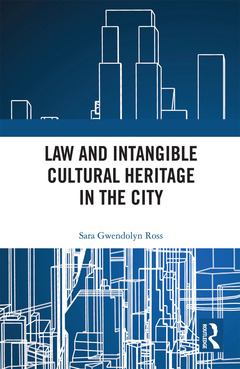Description
Law and Intangible Cultural Heritage in the City
Author: Ross Sara
Language: English
Subjects for Law and Intangible Cultural Heritage in the City:
Keywords
Intangible Cultural Heritage; Young Man; Silver Dollar; Electronic Dance Music Culture; Community Cultural Wealth; Public Engagement; Critical Legal Pluralism; Ontario Municipal Board; Buen Vivir; Intangible Cultural Heritage Protection; Electronic Dance Music Scene; Toronto’s Music; Live Music Venue; Music Venues; Habitat Iii; Heritage Conservation Districts; Spadina Avenue; Toronto Waterfront; Creative Placemaking; Electronic Dance Music; Music City; Habitat Iii Conference; Creative City; Qualitative Ethnographic Methodology; Country Music
Publication date: 03-2021
· 15.6x23.4 cm · Paperback
Publication date: 06-2019
· 15.6x23.4 cm · Hardback
Description
/li>Contents
/li>Biography
/li>
With disappearing music venues, and arts and culture communities at constant risk of displacement in our urban centers, the preservation of intangible cultural heritage is of growing concern to global cities.
This book addresses the role and protection of intangible cultural heritage in the urban context. Using the methodology of Urban Legal Anthropology, the author provides an ethnographic account of the civic effort of Toronto to become a Music City from 2014-18 in the context of redevelopment and gentrification pressures. Through this, the book elucidates the problems cities like Toronto have in equitably protecting intangible cultural heritage and what can be done to address this. It also evaluates the engagement that Toronto and other cities have had with international legal frameworks intended to protect intangible cultural heritage, as well as potential counterhegemonic uses of hegemonic legal tools. Understanding urban intangible cultural heritage and the communities of people who produce it is of importance to a range of actors, from urban developers looking to formulate livable and sustainable neighbourhoods, to city leaders looking for ways in which their city can flourish, to scholars and individuals concerned with equitability and the right to the city. This book is the beginning of a conservation about what is important for us to protect in the city for future generations beyond built structures, and the role of intangible cultural heritage in the creation of full and happy lives.
The book is of interest to legal and sociolegal readers, specifically those who study cities, cultural heritage law, and legal anthropology.
TABLE OF CONTENTS
ACKNOWLEDGEMENTS
INTRODUCTION
CHAPTER ONE: THEORIES OF VALUE, CULTURE AND CULTURAL SPACES IN THE CITY
I. INTRODUCING USE-VALUE VERSUS EXCHANGE-VALUE IN THE CITY
II. CULTURE IN THE CITY: WHAT IT IS AND WHY IT MATTERS
III. RECALIBRATING THE CALCULATION OF BOURDIEUSEAN CULTURAL CAPITAL IN THE CITY
IV. RELATIONALLY VULNERABLE CLAIMS TO HIGH USE-VALUE SPACES OF COMMUNITY CULTURAL AND SUBCULTURAL WEALTH
V. THE INTERNATIONAL RIGHT TO CULTURE AND CULTURE IN THE CITY AS ENSHRINED IN INTERNATIONAL LEGAL FRAMEWORKS
VI. OTHER LEGAL TOOLS FOR PROTECTING THE RIGHT TO CULTURE AND INTANGIBLE CULTURE IN THE CITY
VII. RESPECTING "DIVERSITY" VERSUS DIVERSITY IN CITIES AND CULTURE: BUEN VIVIR AND MOVING TOWARDS AN EQUALITY OF DIFFERENCES
VIII. THEORIES OF HERITAGE, PROPERTY, USE, AND SPACE, AND SUBALTERN COSMOPOLITANISM TO ACHIEVE MORE EQUITABLE TREATMENT FOR PEOPLE IN THE CITY
IX. THE COMMODIFICATION OF CULTURE, REIFICATION OF EXCHANGE-VALUES, AND BARRIERS TO MEANINGFUL ACKNOWLEDGEMENT OF (INTANGIBLE) CULTURAL HERITAGE VALUE, COMMUNITY (SUB)CULTURAL WEALTH, AND USE-VALUE IN THE CITY
CHAPTER TWO: METHODOLOGIES
I. OVERVIEW OF METHODS AND APPROACHES
II. THEORY AND METHODOLOGY OR METHODOLOGY WITH THEORY: INTERDISCIPLINARITY AND URBAN LEGAL ANTHROPOLOGY
III. AN URBAN LEGAL ANTHROPOLOGY AND ETHNOGRAPHIC METHODOLOGY FOR SUBALTERN COSMOPOLITANISM AND COUNTERHEGEMONIC LEGALITY
IV. REFLEXIVITY IN ANTHROPOLOGY AND ETHNOGRAPHY AND INSTITUTIONAL ETHNOGRAPHY METHODOLOGY AS GUIDANCE
V. PARTICIPANT OBSERVATION, INFORMANT ENGAGEMENT, AND THE "WRITING UP" OF FINDINGS
VI. CASE STUDY SITE SELECTION
VII. VIRTUAL COMMUNITIES, VIRTUAL NETWORKS, AND SOCIAL MEDIA
CHAPTER THREE: TORONTO - MUSIC CITY?
I. CREATIVE-CITY INSPIRED REDEVELOPMENT FRAMEWORKS AND THE MUSIC CITY
II. WHAT IS A "MUSIC CITY" AND HOW DOES A CITY LIKE TORONTO BECOME ONE?
III. MUSIC CITIES, HERITAGE PRESERVATION, AND TENSIONS BETWEEN USE-VALUES AND EXCHANGE-VALUES
CHAPTER FOUR: CASE STUDY - WATERFRONT DEVELOPMENT, THE GUVERNMENT, AND DRUM ‘N’ BASS
I. BACKGROUND: A (VERY) BRIEF HISTORY OF DRUM ‘N’ BASS, ELECTRONIC DANCE MUSIC, AND "LIVE" ELECTRONIC MUSIC
II. THE GUVERNMENT: HISTORY, COMMUNITY, SPACE, AND USE
III. OTHER DISPLACEMENT THREATS AND THE IMPORTANCE OF NIGHTTIME MUSIC AND DANCE SPACES
IV. POST-GUVERNMENT AND THE ONGOING POST-INDUSTRIAL SHIFT: WHERE DO THE DISPLACED GO?
V. TORONTO’S WATERFRONT DEVELOPMENT
CHAPTER FIVE: CASE STUDY - THE SILVER DOLLAR ROOM AND COMFORT ZONE
I. BACKGROUND DESCRIPTIONS
II. SILVER DOLLAR ROOM: REDEVELOPMENT THREATS, HERITAGE PRESERVATION, AND READING IN INTANGIBILITY INTO EXISTING HERITAGE LEGISLATION
III. DISPLACED SPACE AND COMMUNITY
CHAPTER SIX: CASE STUDY - BRUNSWICK HOUSE, ALBERT’S HALL, AND THE MATADOR
I. YE OLDE BRUNSWICK HOUSE AND ALBERT’S HALL: DESCRIPTION, HISTORY, VALUE, AND IMPORTANCE
II. THE MATADOR: BACKGROUND, DESCRIPTION, HISTORY, VALUE, AND IMPORTANCE
III. FURTHER BARRIERS TO ATTAINING A LICENSE FOR A "NIGHTCLUB" OR "ENTERTAINMENT FACILITY"
CHAPTER SEVEN: TOWARDS A COUNTERHEGEMONIC USE OF HEGEMONIC LEGAL TOOLS FOR PROTECTING SPACES OF HIGH USE-VALUE AND COMMUNITY CULTURAL WEALTH
I. COUNTERHEGEMONIC POTENTIAL OF HERITAGE MANAGEMENT TOOLS
II. PRECARIOUS PROPERTY AND CREATIVE PLACEKEEPING STRATEGIES: NEIGHBOURHOOD DYNAMIC
Sara Gwendolyn Ross holds a PhD in Law from Osgoode Hall Law School, an LLM from the University of Ottawa, and both a BCL and LLB with a Major in Commercial Negotiation and Dispute Resolution from McGill University. She is a member of the Law Society of Ontario, and from 2018-20, she was both a SSHRC Postdoctoral Fellow and Killam Postdoctoral Laureate at the Peter A. Allard School of Law of the University of British Columbia. Her doctoral and postdoctoral research focussed on the intersection between law and culture in the city, using the novel methodology Urban Legal Anthropology.



